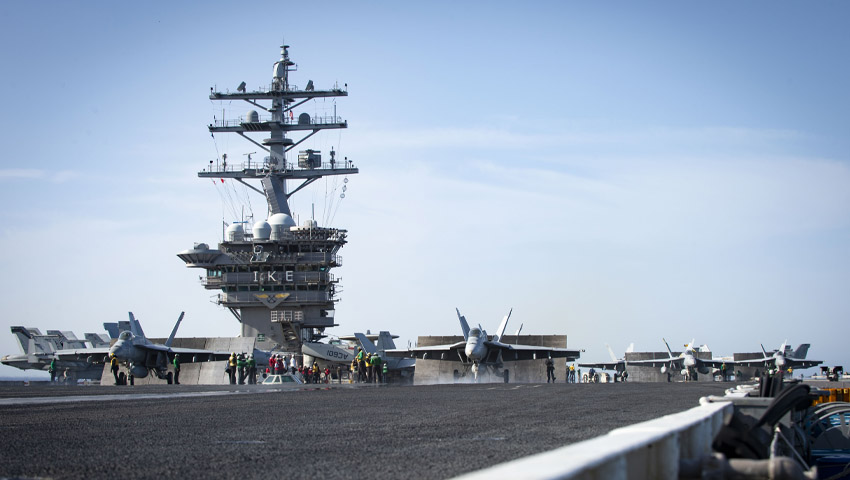As the US Air Force surges ahead with the business case for its ‘digital century’ series of next-generation air combat capability, the US Navy has been given a proverbial kick in the backside by the Senate Armed Services Committee, which told the branch to redouble its efforts to find a replacement for the Hornet-series fighters.
To continue reading the rest of this article, please log in.
Create free account to get unlimited news articles and more!
With the growing success of Russian and Chinese fifth-generation fighter aircraft like the Su-57, J-20 and JF-31, the US has kicked off a suite of development programs to replace the ageing F-15 Eagle and fifth-generation F-22 Raptor air frames and the evolving F/A-18E/F Super Hornets operated by the US Navy beginning in the 2030s.
While the US Air Force has actively progressed its plans to acquire a next-generation air combat capability to replace the Raptor, as outlined in the 2016 'Air Superiority 2030' study conducted by the US Air Force sought to identify the capabilities of the 'Next Generation Tactical Aircraft' air superiority/dominance fighter jet expected to enter service in the 2030s.
The US Navy has been slower to the party, despite kick-starting its F/A-XX Super Hornet replacement program in mid-2008, the branch has made little progress when compared with the US Air Force.
Nevertheless, the Air Force solicitation provides some interesting commonalities between the proposed Next-Generation Air Dominance (NGAD) fighter and the Navy's proposed F/A-XX fighter, driven largely by developments in Russian and Chinese air combat capabilities and the proliferation of increasingly advanced and complex integrated air defence systems like the S-400 and S-500.
The initial stages of this next-generation program, the Next Generation Air Dominance (NGAD) and Penetrating Counter Air (PCA) programs aimed to deliver a:
"Future system [that] will have to counter adversaries equipped with next-generation advanced electronic attack, sophisticated integrated air defence systems, passive detection, integrated self-protection, directed energy weapons, and cyber attack capabilities. It must be able to operate in the anti-access/area-denial (A2/AD) environment that will exist in the 2030-2050 time frame."
As it is expected both the Navy and Air Force platforms will operate in conjunction with one another in the Indo-Pacific, the platforms would naturally have a degree of commonality, with the US Navy's requirements focused on extending the reach of the carrier strike groups, which have become increasingly exposed to advanced Russian and Chinese anti-ship cruise and ballistic missiles.
In light of this, the US Senate Armed Services Committee has laid down the gauntlet for the US Navy as it seeks to play catch up with its Air Force counterpart, ahead of budgetary approval for the FY2021 National Defense Authorization Act (NDAA) telling the branch to come up with a "concrete plan for fielding next-generation fighter aircraft".
Get your act together
While much of the US Navy's acquisition, modernisation and sustainment programs have been focused on big ticket items like the Ford Class supercarriers, acquiring new Virginia Class fast attack submarines, the Columbia Class ballistic missile submarine program and getting the F-35B and F-35C variants into service – the NGAD program has fallen by the wayside.
In response, Congressional oversight saw the requested US$20.7 million for FY2020 slashed to a mere US$7.1 million at a time when the US Air Force was granted just under US$1 billion to support their development program.
To this end, the Senate Armed Services Committee's Fiscal Year 2021: National Defense Authorization Act summary establishes an expectation from the Navy, stating that it "requires the Navy to create a fighter aircraft force structure acquisition strategy and report on aircraft carrier air wing composition and carrier-based strike fighter squadrons to better prepare for potential conflicts envisioned by the National Defense Strategy".
However, this has been met with some confusion as the Navy has failed to identify what the F/A-XX will be when delivered to the fleet, however, this should evolve into a clearer image as the Navy enters a concept development phase.
Nevertheless, there is still a lack of consensus on the next-generation fighter, with Bryan Clark, a senior fellow at the Hudson Institute, testifying before the House Armed Services Committee (HASC) that it would make sense to keep buying the F/A-18s to keep the line hot for a potential F/A-XX.
"I think the F/A-XX is going to need to be probably a derivative of an existing airplane rather than some complete new clean sheet design given the fiscal constraints we're under. Therefore, keeping production lines going for both of our existing strike fighters is a good idea to allow both to be an option for this future F/A-XX," Clark told the HASC.
Yours thoughts
The increasingly challenging operating environment emerging on Australia’s doorstep – combined with similar concerns developing among allies, including the US, UK and, more broadly, the European Union – raises questions about the Royal Australian Air Force’s plans to adequately defend Australia’s airspace against increasingly capable threats.
Accordingly, is it time for Australia to be involved with the development and introduction of a highly capable, high-speed, low-observable, air superiority-focused platform to complement the low-end capability of other platforms, future-proofing the capability and enhancing the interoperability of the Royal Australian Air Force and allied air forces?
For Australia, the future operating environment to the nation’s immediate north will necessitate investment in a highly capable, long-range, air dominance fighter aircraft to complement the F-35 Joint Strike Fighters and replace the ageing F-18 E/F Super Hornets by the mid 2030s.
The growing number of next-generation air combat development programs in the US, UK and European Union provides the nation with multiple avenues to pursue to ensure that the Royal Australian Air Force establishes and maintains a regionally superior air dominance capability.
Get involved with the discussion and let us know your thoughts in the comments section below, or get in touch with
Stephen Kuper
Steve has an extensive career across government, defence industry and advocacy, having previously worked for cabinet ministers at both Federal and State levels.

 Login
Login








